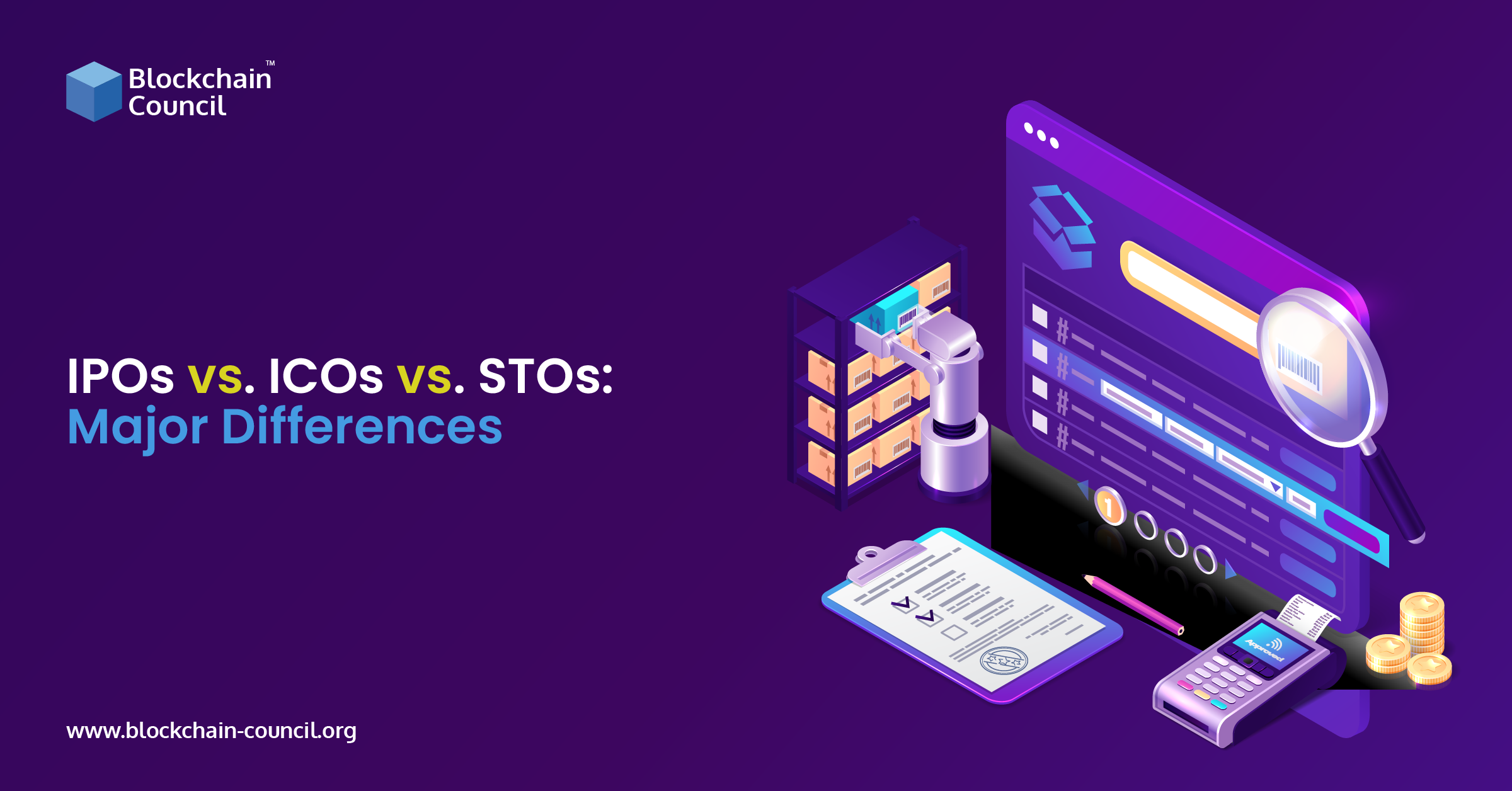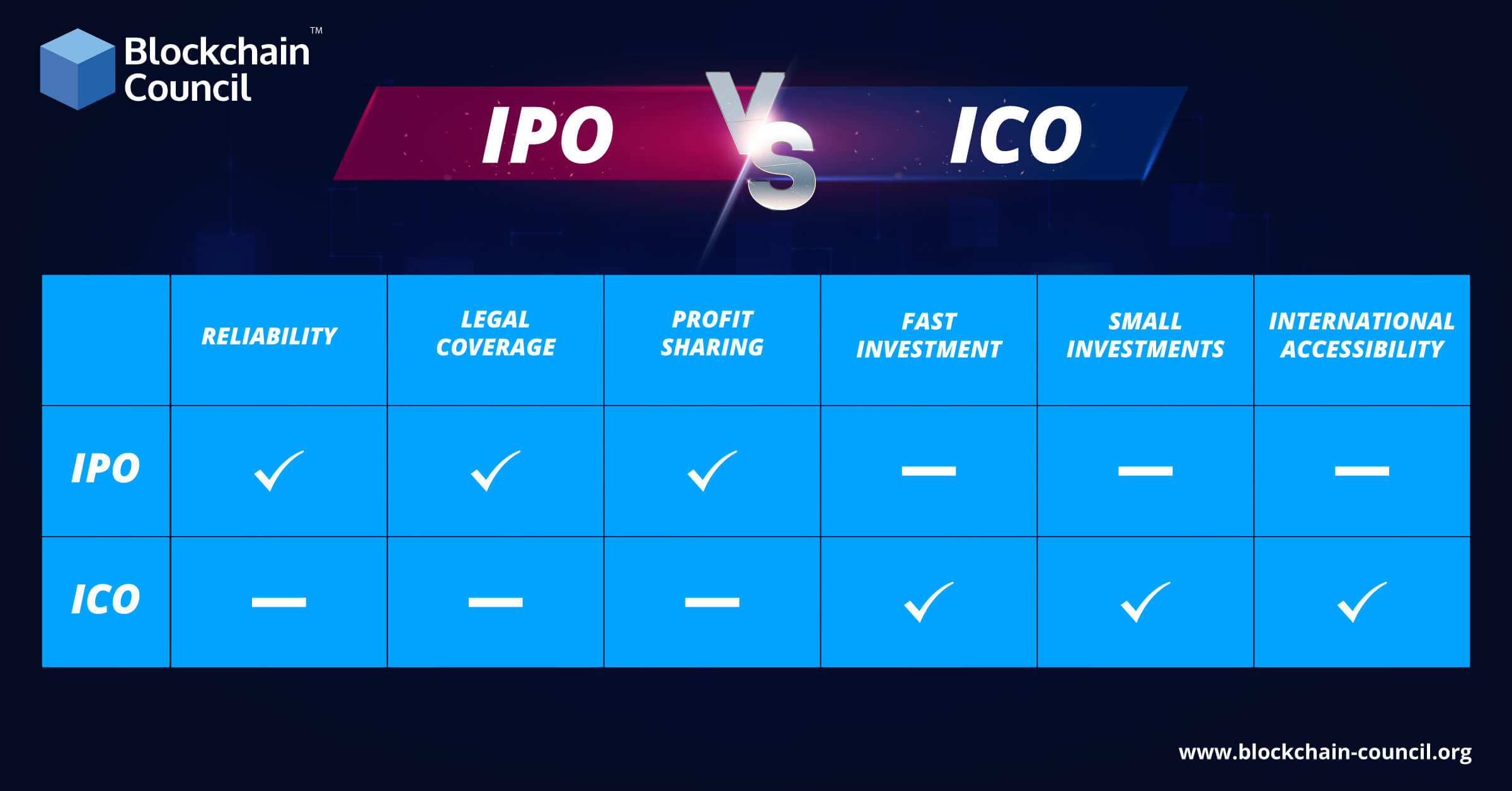
- Toshendra Kumar Sharma
- March 22, 2022

The modern businesses use IPOs (Initial Public Offerings), ICOs (Initial Coin Offerings), and STOs (Security Token Offerings) fundraising methods to obtain funds.
Whether a company decides to sell blockchain-based digital assets via ICOs or STOs, or traditional stock market shares via an IPO, one of the key aims of entrepreneurs is to raise money because it will likely determine whether a project succeeds or fails. As a result, a firm must make the appropriate efforts to get enough funding to develop.
If you want to learn more about the many methods of fundraising, you’ve come to the perfect spot. In this article, we’ll look at the key distinctions between crypto offerings but first, let us understand the IPO, ICO, and STO concepts.
Blockchain Council is an educational platform that not only engages its audience with the trending blockchain technology but also offers the best blockchain certification courses.
Initial Public Offering (IPO): An Overview
Initial Public Offerings (IPOs) are private company share offerings to the general public by the issuance of new stock, transforming a private organization into a public company. Typically, an underwriter is appointed, and the shares are subsequently listed for trade on an exchange. Initial Public Offerings (IPOs) allow companies to tap into a pool of public investors who can provide funding. Prospective shareholders receive a stake in the firm in exchange for their investment. Furthermore, because they are governed by EU-wide regulation, IPOs are transferable across all EU and EEA member states.
Thus, some of the advantages of IPOs include additional cash, corporate development, transparency, and the possibility of enhanced liquidity through a secondary listing. They are, however, highly regulated and, as a result, more expensive than other means of obtaining cash. The company is also exposed to competitive threats since sensitive information such as financial and tax information must be given to the public. Furthermore, there is a loss of control since additional owners get voting rights, essentially reducing the influence of current shareholders in decision-making.
Initial Coin Offering (ICO): An Overview
ICOs entail the production of fresh tokens, which are then issued to investors in trade for cryptocurrencies or fiat currency. The token often provides some type of usefulness inside the issuer’s product or service or other rights that, in their entirety, do not contain the rights associated with a traditional stock.
Initial Coin Offerings (ICOs) are used to generate capital in the same way that IPOs are, but the commonalities end there. The key distinction is the use of blockchain platforms as a mechanism of distribution rather than releasing tokens that do not contain equity rights.
Before launching an ICO, a white paper outlining the project’s details must be released. This allows start-ups to acquire financing without the constraints imposed by traditional IPOs, as well as without any limits on the sort of investors that may participate, as ICOs are often available to regular investors.
There are various advantages to using ICOs, the most notable of which is that they are mainly unregulated in most countries, except for generally applicable regulations such as anti-money laundering legislation. Because tokens are distributed automatically when using blockchain, the process is sped up, and this ease of transaction allows for quick fundraising. However, a lack of regulation has historically resulted in multiple fraudulent ICOs, resulting in a low reputation in recent years.
Security Token Sale (STO): An Overview
Security Token Offerings (STOs) include elements of both initial public offerings (IPOs) and initial coin offerings (ICOs). While the issue of tokens or coins on a blockchain is involved, the tokens are classified as securities since they frequently represent an underlying asset like stocks, bonds, or mutual funds. Because they are securities, they are subject to traditional securities laws, including the Markets in Financial Instruments Regulation, Markets in Financial Instruments Directive, Prospectus Directive, and Transparency Directive, all of which are controlled by European Union law.
While regulation gives greater legitimacy than ICOs, the procedure is more time-consuming and requires additional regulations owing to the application of standard securities legislation. STOs, on the other hand, are still more cost-effective and faster to execute than IPOs, thanks to the use of blockchain technology. STOs, like IPOs, are usually passportable throughout EU and EEA member states. However, security tokens suffer a liquidity problem at the present because they have yet to be listed on any major stock exchanges due to the innovative technology they utilize.
What do you mean by Fundraising?
The idea of fundraising was initially established in the early 1900s, and it was mostly linked with money generated for philanthropic reasons. Face-to-face fundraising, events, and Public Relations (PR) efforts were the primary methods utilized by organizations to generate donations.
The introduction of online social media campaigns and internet-enabled worldwide communication has given financing and capital raising a new viewpoint. Other means to raise funds in crowdfunding initiatives that leverage blockchain technology have emerged as a result of the cryptocurrency field.
The YMCA — Young Men’s Christian Association, a non-profit organization that helps impoverished youngsters, developed the first and most successful campaign. Frank Pierce and Charles Ward, two fundraisers, could generate an incredible $4 million for the YMCA of New York City alone. Through a sound advertising strategy and face-to-face approaches, they established a trend of innovative fundraising campaigns that shaped the future of capital acquisition.
In 2013, the peer-to-peer (P2P) Mastercoin project launched its inaugural token sale, raising the equivalent of about $500,000 in newly-minted Mastercoins in exchange for Bitcoin. That was the first initial coin offering, and the success of this fundraising effort prompted other companies to adopt the Bitcoin network for peer-to-peer finance.
The Ethereum token sale in 2014 raised 3,700 BTC in the first 12 hours, which was equivalent to $2.3 million at the time. The money raised was utilized to turn Ethereum into a fully functional blockchain that isn’t reliant on Bitcoin.
Initial Coin Offering (ICO) vs. Security Token Offering (STO)
The fundamental distinction is in the nature of the digital asset being given. Digital assets are considered as utilities in an ICO and can be issued indefinitely. They’ve shown to be highly speculative assets over time since their value is based on the imagined advantage purchasers expect them to give rather than real value.
Pump and dump schemes have long been connected with ICOs, which the regulator sees as a major red flag. Security token offers, on the other hand, are related to a more established corporation and reflect genuine securities such as bonds or equities.
There is also a big difference in accordance with the rules. STOs, like typical IPOs, are classified as securities, but ICOs are classified as utilities, implying a shadier and less transparent structure. As a result, STOs provide additional safety to businesses by requiring tokens to be registered and evaluated by the local security and exchange commission.
STOs ensure that every transaction is supervised by the appropriate authorities, and while transactions and investment procedures take longer, investors feel safer and are less likely to fall victim to fraud.
Initial Public Offering (IPO) vs. Initial Coin Offering (ICO)
IPOs are used by well-established corporations to generate capital, whereas ICOs are used by fresh, young enterprises to raise funds.
One of the most significant distinctions is what the investor receives in return for the funds. In the event of an initial public offering (IPO), the investor receives equity (ownership of assets that may be subject to debts or other obligations) as well as voting power in the firm.
An ICO investor does not possess company equity or have the capacity to vote on important internal decisions. The value of a coin is generally determined by the rights represented by the token, as well as the progress of any underlying project.
ICOs take place when a blockchain-based firm first launches. A private firm, on the other hand, decides to go public at a later time once it has grown into a more stable business and has a proven product or service.
Another key difference between an ICO and an IPO is regulation. An ICO is mostly self-regulated through automated and digital smart contracts, whereas an IPO must go through stringent procedures, due diligence, and compliances before being accepted by the appropriate local regulatory agency.
The fundamental advantage of an ICO over an IPO is that it eliminates the need for intermediaries, which may make procedures more time-consuming, inefficient, and expensive.
Which is the better option: IPOs vs. ICOs vs. STOs?
While raising capital is an important step for many businesses, deciding which approach to use may be difficult. However, it is impossible to establish the most successful manner of generating donations objectively. While ICOs in most countries provide near-complete deregulation and virtually unfettered sources of money, they lack the same legitimacy as carefully regulated IPOs.
STOs may be subject to the same set of regulations as IPOs, with the primary differences being the usage of blockchain technology and the fact that STOs do not always have to be stock offerings and hence have a broader scope.
| Differentiating Aspect | Initial Public Offerings (IPOs) | Initial Coin Offerings (ICOs) | Security Token Offerings (STOs) |
| Introductory process | Before launching an IPO, corporations must meet a number of requirements and obtain clearance from the competent authorities that oversee securities and exchanges. | There is no requirement for authority permission or compliance. Only technical expertise and an effective marketing strategy are required to set up a smart contract on a blockchain. | Conformity with the appropriate jurisdiction’s security laws National financial supervisory authorities must regulate and authorise it. |
| Firm infrastructure | Large | Small and mid-sized | Small and mid-sized |
| Requirement | Lawyers and underwriters are involved in a protracted procedure. | A rapid and simple automated process is possible on a blockchain | Even though legislation necessitates paperwork and complexity, an automated approach on a blockchain is possible. |
| Operational Costs | High operational costs. | Low than the operational costs of IPOs and STOs. | Can range from low to medium. |
| Exposure | Only within the jurisdiction in which the IPO is generated. | It has a global exposure. | While STO compliance necessitates a certain jurisdiction in order to issue tokens, investors can be anywhere in the world as long as they abide by local regulations. |
| Privileges | Investors receive voting rights as well as a part in the company’s future earnings. | Ability to profitably acquire and sell the company’s tokens | Dividends, profit participation, voting rights, and stock are all available to investors. |
Finally, one must strive to strike a balance between traditional securities’ regulatory certainty and the flexibility and efficiency provided by novel technologies such as blockchain.
According to recent reports, the demand for blockchain technology training courses in India is increasing. This is owing to the numerous job prospects provided by blockchain technology.
If you have no idea where to begin, you might definitely start by enrolling in blockchain courses. The Blockchain Council offers a variety of certification courses that are simple to enroll in.






































































 Guides
Guides News
News Blockchain
Blockchain Cryptocurrency
& Digital Assets
Cryptocurrency
& Digital Assets Web3
Web3 Metaverse & NFTs
Metaverse & NFTs
